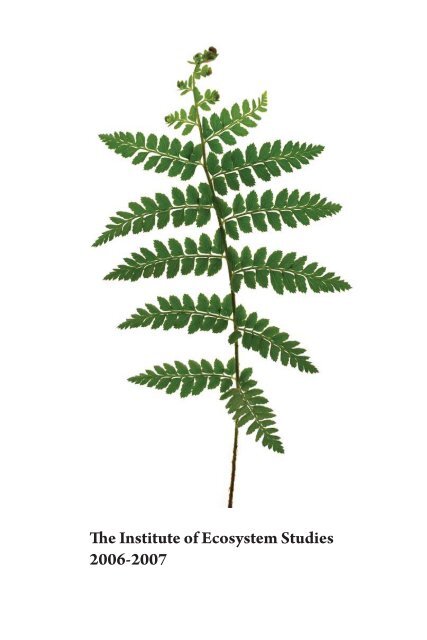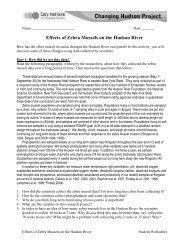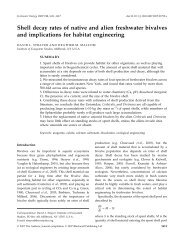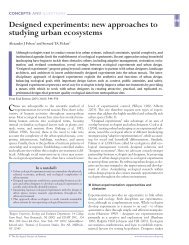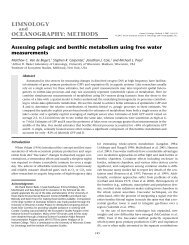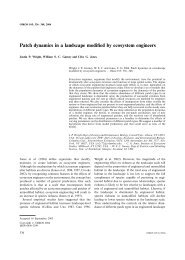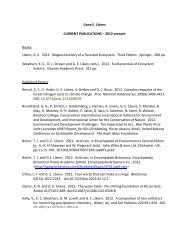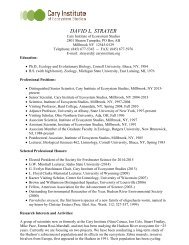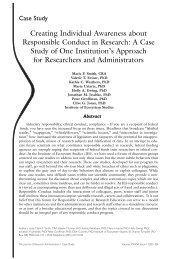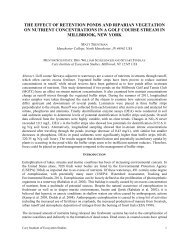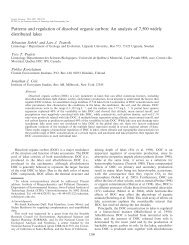Biennial Report Book 2007.indb - Cary Institute of Ecosystem Studies
Biennial Report Book 2007.indb - Cary Institute of Ecosystem Studies
Biennial Report Book 2007.indb - Cary Institute of Ecosystem Studies
You also want an ePaper? Increase the reach of your titles
YUMPU automatically turns print PDFs into web optimized ePapers that Google loves.
The <strong>Institute</strong> <strong>of</strong> <strong>Ecosystem</strong> <strong>Studies</strong>2006-2007
IndexThe Science Behind the Solutions 01Letter from the President 022005-2007 in Review 03-12Scientific Staff 13-16Board <strong>of</strong> Trustees 17-19Financial Pr<strong>of</strong>ile 20Supporters 21-32Volunteers 33-35Full Staff 36-39
Lori M. Quillen<strong>Institute</strong> <strong>of</strong> <strong>Ecosystem</strong> <strong>Studies</strong>The Science Behind the SolutionsThe <strong>Institute</strong> <strong>of</strong> <strong>Ecosystem</strong> <strong>Studies</strong> provides the science behindenvironmental solutions. For nearly twenty-five years, our scientists havebeen investigating the complex connections that govern the natural world,and their objective findings lead to more effective policy decisions andincreased environmental literacy. Today as society faces climate change,declining supplies <strong>of</strong> fresh water, urban sprawl, and other critical challenges,the <strong>Institute</strong> is one <strong>of</strong> the most influential ecological research organizations.Decision makers, land managers, educators, and the public look to ourscientists to help shape the environment we will leave for future generations.1
<strong>Institute</strong> <strong>of</strong> <strong>Ecosystem</strong> <strong>Studies</strong>Letter from the PresidentSince arriving at the <strong>Institute</strong> <strong>of</strong> <strong>Ecosystem</strong> <strong>Studies</strong> in late May <strong>of</strong> 2007, I have beeninspired by the scope and strength <strong>of</strong> the organization’s research program. Theenclosed report summarizes activities from 2005 – 2007. It is a tribute to the fineleadership <strong>of</strong> Dr. Gene E. Likens; over the past twenty-five years he built and led the<strong>Institute</strong> to a position <strong>of</strong> international prominence in environmental research. Thepast several years have been no exception to this trajectory.In 2007, <strong>Institute</strong> scientists published over 90 papers in the primary scientificliterature, including a wide selection in the premier journals <strong>of</strong> ecology, includingBiogeochemistry, Ecology, Ecological Applications, Global Change Biology, Limnology andOceanography, Nature, <strong>Ecosystem</strong>s, and Science. Staff were called before local, state,and national legislative bodies to <strong>of</strong>fer expert testimony on pressing environmentalissues, such as climate change. Print and video media captured the excitement andimportance <strong>of</strong> <strong>Institute</strong> research, with coverage in The New York Times, The BostonGlobe, and the Poughkeepsie Journal.This report is primarily a financial review <strong>of</strong> the <strong>Institute</strong>’s operations. We havebenefited from the gracious provision <strong>of</strong> nearly $3.5 million each year from the MaryFlagler <strong>Cary</strong> Charitable Trust. Operating funds are also derived from the <strong>Institute</strong>’sown endowment earnings and from overhead revenues derived from extramuralgrants received by our scientists. During the past few years, the outlook for Federalgrants has darkened considerably and our grant funding has dropped slightly, but<strong>Institute</strong> scientists still have a 30% success rate amongst submitted proposals—nearlyfour times the national average!Over the past year, I have initiated a program <strong>of</strong> strategic planning for the future<strong>of</strong> the <strong>Institute</strong>, including plans for new scientific staffing, enhanced publiccommunications, and changes in our grounds. We are at a critical juncture; theorganization must focus its resources on activities that support its core scientificmission. Moving forward, outreach programming will strive to educate visitors andthe general public about the ecosystem concept and its importance to environmentalscience.Again, I am proud to have been chosen to lead the <strong>Institute</strong> and promise to carry it tonew levels <strong>of</strong> impact with regard to our nation’s pressing environmental issues.Dr. William H. Schlesinger, President2
2005-2007 In Review3
<strong>Institute</strong> <strong>of</strong> <strong>Ecosystem</strong> <strong>Studies</strong>A Scientific Review, 2005 - 2007AIRThe <strong>Institute</strong> has a strong history <strong>of</strong> analyzing how airborne pollutants impactecosystems. Research by the organization’s founder, Dr. Gene E. Likens, informedClean Air Act Amendments that have been instrumental in reducing acid rain.<strong>Institute</strong> scientists continue to explore how airborne pollutants influence theenvironment, with research sites worldwide, including New York’s Catskill Forest,Maine’s Acadia National Park, and southern Chile.Threats from above: Air pollution effects on biodiversityThe <strong>Institute</strong> provided leadership on a Nature Conservancy report detailing the impact<strong>of</strong> airborne pollutants (sulfur, nitrogen, ozone, and mercury) on plants and animals inthe Northeast and Mid-Atlantic States. All <strong>of</strong> the ecosystems studied were impacted,with many suffering damage from multiple pollutants. If species and habitats are tobe conserved, the report recommends that conservation organizations become moreinvolved in creating national air pollution policy. (Lovett)Nitrogen air pollution and tree mortality<strong>Institute</strong> researchers found that when trees are fertilized with nitrogen over a period<strong>of</strong> several years, they have an elevated mortality rate compared to unfertilized trees.While nitrogen is traditionally viewed as a plant fertilizer, this research suggests thatexcess nitrogen from air pollution may be harmful to forest ecosystems. (Lovett)LANDFrom the state <strong>of</strong> the world’s forests, to ecological conditions in urban areas, <strong>Institute</strong>scientists are actively investigating the terrestrial environment. Our research hasproduced a better understanding <strong>of</strong> invasive forest pests, ecological models thatfacilitate sustainable forestry, and predictions <strong>of</strong> how climate change will influenceforest function.Predicting forest response to exotic pests and pathogensExotic pests are one <strong>of</strong> the biggest threats facing forests in the Northeastern UnitedStates. To understand the scope <strong>of</strong> the problem, a team <strong>of</strong> <strong>Institute</strong> scientistsperformed an extensive review <strong>of</strong> the impacts that introduced insects and diseaseshave on forested ecosystems. The team developed a conceptual framework tohelp assess ecosystem-scale effects <strong>of</strong> invaders, and the findings were published inBioscience. (Lovett, Canham, Weathers)Understanding climate change impacts on forestsFor over 16 years, <strong>Institute</strong> research has been looking at forest structure inConnecticut’s Great Mountain Forest. Long-term research on tree competitiondynamics, published in Ecological Applications, has set the stage for understanding thepotential effects <strong>of</strong> climate change on both the demography and distribution <strong>of</strong> foresttrees. (Canham)4
Ecological models guide sustainable forestryThe <strong>Institute</strong> is collaborating with the British Columbia Forest Service on a project tounderstand the dynamics <strong>of</strong> cedar-hemlock forests. A modeling program called SORTIE,developed at the <strong>Institute</strong>, will be used to help guide sustainable partial harvestingstrategies. (Canham)Forest soils and gas fluxGases such as nitrous oxide, carbon dioxide, and methane are linked to global climatechange. <strong>Institute</strong> research is examining the relationship between decreasing averagesnow depth and the flux <strong>of</strong> these gases in northern hardwood forests. The work,published in Global Change Biology, indicates that warmer winters will lead to anincrease in nitrous oxide production and a decrease in methane uptake. Nitrous oxidefluxes were higher than expected, suggesting that forests play an important role in theglobal budget <strong>of</strong> this gas. (Gr<strong>of</strong>fman)Dead wood linked to nitrogen retentionDead wood plays a role in nutrient cyclingin old growth forests. As forests in thenortheastern United States mature, deadwood is likely to become an importantfactor in these ecosystems. <strong>Institute</strong> researchhas demonstrated that when dead woodincreases, the loss <strong>of</strong> dissolved organiccarbon in streams is enhanced but forestsoils retain more nitrogen. Results werepublished in Biogeochemistry. (Gr<strong>of</strong>fman)HERCULES: A tool for analyzing urbanland coverEffective urban planning relies on anunderstanding <strong>of</strong> the distinct patches (orneighborhoods) that, in aggregate, make upurban ecosystems. Each patch has uniquebiological, social, and physical characteristics. With colleagues, the <strong>Institute</strong> has createda land cover classification system that provides insight into the integration <strong>of</strong> patchstructure in urban Baltimore. The system will help inform future sustainable urbandesign initiatives. (Cadenasso)Charlie CanhamThe secret to successful invadersFrom forest pests to predatory fish, thousands <strong>of</strong> invasive exotic animals are shapingecosystem function and species survival around the world. What makes some speciesso good at spreading into new territory? <strong>Institute</strong> research is unraveling how biologicaltraits, association with humans, and repetitive introduction attempts influence invadersuccess. Results have been published in Trends in Ecology and Evolution and Global ChangeBiology. (Jeschke, Strayer)5
Deer and forest healthIn 2007, the <strong>Institute</strong>’s Deer Management Program received a Certificate <strong>of</strong> Recognitionfrom the Northeast Section <strong>of</strong> The Wildlife Society. The award recognized the longterminsight that the program has generated about using managed hunting as a tool forprotecting the structure and function <strong>of</strong> forested ecosystems. (Winchcombe)WATERAs a result <strong>of</strong> <strong>Institute</strong> research, the Hudson River is one <strong>of</strong> the most scrutinized rivers inthe world. In addition to helping to understand a local resource, this knowledge can beapplied to the management <strong>of</strong> rivers globally. Our scientists continue to reveal criticalinformation about freshwater ecosystems, including lakes and streams. This work hasprovided essential insight into how human-induced environmental change impactsfreshwater resources.Putting streams on a low salt dietStream chloride concentrations are rising at a rate that threatens freshwater availability.Using long-term monitoring from Maryland, New Hampshire, and New York, ourscientists have helped determine that rising salinity is largely derived from an increasein the use <strong>of</strong> chloride-based road deicers. Results, published in the Proceedings <strong>of</strong> theNational Academy <strong>of</strong> Sciences, warn that if salinization continues at the current rate, overthe next century stream water in the northeastern United States will be unfit for humanconsumption and toxic to wildlife. (Gr<strong>of</strong>fman, Kelly)Nutrient pollution, climate change, and a rise in toxic planktonHuman activities, such as fertilizer use and shoreline development, cause nutrientpollution that stimulates phytoplankton blooms. Climatic conditions can impact the type<strong>of</strong> phytoplankton that occur. <strong>Institute</strong> research on the Hudson River has linked warmersummer waters to an increase in a potentially-toxic phytoplankton called cyanobacteria.An increase in cyanobacteria could degrade the Hudson as a source <strong>of</strong> drinking water andalter the river’s food web. (Caraco, Cole)Nuisance algae in nutrient-poor lakesGloeotrichia echinulata has begun to bloom in northern New England lakes. While it isa common cyanobacterium in nutrient-rich lakes, it is unusual in these nutrient-poorsystems. With colleagues at Dartmouth and Bates Colleges, <strong>Institute</strong> research is exploringhow this nuisance alga thrives by accessing phosphorus that is stored in lake sediments.(Weathers)Mist connections: The importance <strong>of</strong> fog in the maintenance <strong>of</strong> ecosystemsFog delivers water, nutrients, and pollutants to coastal and montane ecosystems. <strong>Institute</strong>research is investigating how fog water contributes to ecosystem function along the coasts<strong>of</strong> California, Chile, and Maine. Because some fog originates in marine systems, researchis also trying to answer the question, “Is the ocean feeding the forest?” (Weathers)6
Kara GoodwinMapping Hudson River habitats<strong>Institute</strong> scientists are mapping the extent, diversity, and function <strong>of</strong> Hudson Riverhabitats, from benthic substrates to shoreline patches <strong>of</strong> submerged vegetation. Thiseffort has revealed important information about how rivers function. For instance,it is now clear that native submerged plants oxygenate the water while large beds <strong>of</strong>invasive water chestnut can cause anoxic conditions. This research was published in<strong>Ecosystem</strong>s and BioScience. (Findlay, Caraco)The Hudson River as a pipe and a reactorRivers are not simply pipes that transport materials between the land and thesea. Through microbial activity, rivers transform the materials they transport. Anassessment <strong>of</strong> the Hudson River revealed that it transports a large amount <strong>of</strong> terrestrialmatter to the sea, with 20% <strong>of</strong> inputs being degraded along the river’s flow path.Measurements <strong>of</strong> transport and microbial processing will help predict downstreamwater quality. (Pace, Fischer)Water chestnut management: Weighing impactsWater chestnut, an invasive aquatic plant, is established in the Hudson River. Largeplant beds can cause anoxia and impediments to boating. Indiscriminant plantremoval, however, is not recommended. <strong>Institute</strong> research has revealed that plantsalso play a positive role in removing excess nitrogen from the water column. Thisservice should be balanced against negative impacts. New York State’s water chestnutmanagement plans have been influenced by this research. (Caraco, Findlay)Do aquatic ecosystems run on alternative fuel?In an effort to understand the role <strong>of</strong> terrestrial matter in lake food webs, an <strong>Institute</strong>study used carbon-13 to trace the food web in a large lake. By labeling aquatic plants,researchers were able to differentiate between aquatic and terrestrial inputs. Bacteria,small animals, and water-column fish were mainly supported by aquatic plants, butbenthic animals and benthic-feeding fish were supported by a mix <strong>of</strong> aquatic andterrestrial materials. Results were published in <strong>Ecosystem</strong>s. (Cole, Pace)7
Elephants, surface water, and the survival <strong>of</strong> riparian plants<strong>Institute</strong> research in South Africa is investigating the integration <strong>of</strong> riparian zones andupland savanna in Kruger National Park. Riparian zones at the edge <strong>of</strong> rivers can playa critical role in the movement <strong>of</strong> organisms and resources across landscapes. Ongoingstudies are elucidating the relationship between surface water availability, elephantimpacts, and the condition <strong>of</strong> riparian plant communities. (Pickett, Cadenasso)Adirondack watersheds reveal lake chemistry<strong>Institute</strong> research is pioneering a new spatially-explicit approach to predicting lakechemistry based on the characteristics <strong>of</strong> adjacent watersheds. Using a retr<strong>of</strong>itted lightaircraft, researchers are sampling remote lakes and correlating phosphorus and nitrogeninputs to watershed attributes. Initial findings challenge long-held assumptions about theconnection between watersheds and inland waters. (Canham, Pace)Charlie CanhamThe global carbon budget: Pay attention to inland watersCarbon continually cycles through terrestrial systems, inland waters, the ocean, and theatmosphere. Because inland water bodies cover less than 1% <strong>of</strong> the Earth's surface, untilrecently it was assumed that their contributions were inconsequential. With colleagues,<strong>Institute</strong> researchers have shown that inland water bodies are important areas <strong>of</strong> terrestrialcarbon transformation that deserve inclusion in global carbon cycle assessments. Thisresearch was featured in <strong>Ecosystem</strong>s. (Cole, Caraco)Pearly mussel ecology: Disappearing gemsOnce abundant in rivers, streams, and lakes around the world, pearly mussel populationsare severely imperiled by human activities. A book recently published by the University<strong>of</strong> California Press, details how multiple factors (dispersal, habitat, fish hosts, food,and predation) control the distribution and abundance <strong>of</strong> these important and <strong>of</strong>tenmisunderstood animals. (Strayer)8
HEALTHOver the past several decades, animal-borne infectious diseases have beenincreasing in scope and magnitude. <strong>Institute</strong> research has revealed key linksamong ecosystem health, biodiversity, and the prevalence <strong>of</strong> infectious diseasessuch as Lyme disease and West Nile virus. Inroads have also been made inunderstanding how pulsed resources—periods <strong>of</strong> superabundance and periods <strong>of</strong>scarcity—impact Lyme disease cycles.Biodiversity buffers disease transmissionWith colleagues, <strong>Institute</strong> researchers have created a theoretical foundation forunderstanding how biodiversity influences disease transmission to humans, otheranimals, and plants. A scientific literature review and ongoing Lyme diseaseresearch have revealed that high biodiversity suppresses disease transmission andprotects human health. This research was published in Ecology Letters and PublicLibrary <strong>of</strong> Science (PLoS) Medicine. (Ostfeld)Pulsed resources and disease prevalenceEpisodic production <strong>of</strong> food resources, such as acorns and other seeds, influencesanimal survival in northeastern forests. <strong>Institute</strong> research has found that whitefootedmouse and eastern chipmunk populations increase the year after heavyacorn crops. A rise in the density <strong>of</strong> white-footed mice, in turn, leads to morepathogen-infected ticks and higher human incidence <strong>of</strong> Lyme disease. Findingshave been published in Public Library <strong>of</strong> Science (PLoS) Biology and EcologicalApplications. (Ostfeld)Innovations in tick controlControlling tick abundance would help protect human health, but traditionalcontrol methods are pesticide-based and environmentally destructive. <strong>Institute</strong>research, published in BioScience, has identified native fungi that can be used tosafely and effectively reduce tick populations. (Ostfeld)EDUCATIONThe <strong>Institute</strong> is working to increase ecosystem literacy at all educational levels.Our <strong>of</strong>ferings engage advanced learners, undergraduates, teachers, and students.Innovative curricula and targeted workshops, created by the <strong>Institute</strong>’s EducationProgram staff, aim to advance ecological understanding in K-12 settings.The next generation <strong>of</strong> ecologistsDuring the period covered by this report, <strong>Institute</strong> scientists advised over 70graduate students from 30 different universities, including seven from abroad.In addition to mentoring students, the <strong>Institute</strong> hosts a yearly Fundamentals <strong>of</strong><strong>Ecosystem</strong> Ecology course that attracts students from around the country. Taughtby an array <strong>of</strong> <strong>Institute</strong> staff, the course is an immersion in current ecologicalthinking. (Findlay)9
The Research Experiences for Undergraduates (REU) programFor over 20 years, the <strong>Institute</strong> has <strong>of</strong>fered research experiences to undergraduatestudents. Working closely with a mentor, students spend the summer workingon a hands-on independent research project. Our formal assessments show thatthe REU program leads to an increase in student self confidence, critical thinkingskills, and future career success. (Berkowitz)The Changing Hudson Project: Connecting students with scienceUsing real data and current ecological findings, <strong>Institute</strong> staff and practicingteachers are working together to create a web-based resource for high school andcommunity college educators. The Changing Hudson Project features lesson plansthat enable teaching about ecosystems, including how they change, and whatthese changes mean for the future. (Harris, Berkowitz)Pathways to ecosystem literacy: A learning progressionIn a collaborative effort with Millbrook Central School District, <strong>Institute</strong>educators are developing a learning progression that engages K-12 students inecological understanding. This project was presented with a Green AchievementAward by Dutchess County Executive William R. Steinhaus. (Notin, Berkowitz)Investigating urban ecosystemsWorking with the Baltimore <strong>Ecosystem</strong> Study (BES), educators, and classroomteachers, the <strong>Institute</strong> is developing curriculum materials and on-goingpr<strong>of</strong>essional development to teachers across Baltimore. The goal: to encouragemiddle and high school teachers to investigate the ecology <strong>of</strong> metropolitanBaltimore through BES data and their own research. (Gordon, Berkowitz)Cornelia Harris10
What is ecosystem or ecological literacy?<strong>Institute</strong> educators are leading a nation wide effort to define ecosystem andecological literacy as essential components <strong>of</strong> what every person needs for soundenvironmental citizenship. A survey <strong>of</strong> Ecological Society <strong>of</strong> America members ishelping shape this definition, and will lay the groundwork for assessments andactions to gauge and increase ecological understanding. (Berkowitz)OUTREACHThe <strong>Institute</strong> is committed to sharing research findings with a diversity <strong>of</strong> publicaudiences. Ecological expertise is shared through lecturing, hosting workshops,advising resource managers, writing for newspapers and magazines, participatingin national conferences, <strong>of</strong>fering testimony at Congressional hearings, andappearing before local civic groups.Who needs environmental monitoring?Long-term environmental research is at the heart <strong>of</strong> effective environmentalpolicy. Due to government funding cuts, however, sustaining long-term researchis a challenge. After authoring a paper in Frontiers in Ecology and Environment onthe scientific value and cost-effectiveness <strong>of</strong> environmental monitoring, <strong>Institute</strong>researchers and colleagues helped educate Capitol Hill policy makers about therole that long-term monitoring plays in policy formation and evaluation. (Lovett)A partnership with the Poughkeepsie JournalIn an effort to share research findings with diverse public audiences, the <strong>Institute</strong>has teamed up with the Poughkeepsie Journal to <strong>of</strong>fer Ec<strong>of</strong>ocus, a biweekly ecologycolumn. Rotating authorship allows <strong>Institute</strong> researchers and educators to sharetheir expertise with Hudson Valley residents. (Quillen)Public programming: Forging local connectionsThe <strong>Institute</strong> is committed to engaging local audiences in science discovery. Ourmonthly Weekend Ecology Education Programs introduce guests to ecosystemconcepts. Past programs have explored butterfly habitats, amphibian life,human-induced forest change, and the ecology <strong>of</strong> maple sugaring. Other publicprogramming included a Climate Change Workshop and a screening <strong>of</strong> AnInconvenient Truth with a post-movie Q&A session.CARY CONFERENCESOn a biennial basis, the <strong>Institute</strong> hosts an internationally-renowned scientificconference series that was formed to encourage discourse on cutting-edge topicsin ecology. Initiated in 1985, over 400 scientists from more than 22 countrieshave gathered at the <strong>Institute</strong> to examine fundamental emerging issues.11
<strong>Cary</strong> Conference XII: Ecological designThe <strong>Institute</strong>’s twelfth biennial <strong>Cary</strong> Conference, held in 2007, focused on howurban designers can incorporate ecological principles into the way that urbanareas are developed. Attendees included some <strong>of</strong> the nation’s foremost ecologists,urban planners, architects, and landscape architects. The conference’s main goalwas to share expertise in a way that supports environmentally sustainable urbandesign. (Pickett)<strong>Cary</strong> Conference X: Proceedings availableWhile <strong>Cary</strong> Conferences are invitation-only,proceedings are published in book form. Themost recent installment, <strong>Ecosystem</strong> Function inHeterogeneous Landscapes, is now available fromSpringer Publishers. The book, which covers thetenth conference, addresses how interactionsamong ecosystems affect the functioning <strong>of</strong>individual ecosystems and the larger landscape.(Lovett)PUBLICATIONSOver the past two years, <strong>Institute</strong> scientistshave published more than 170 papers in peerreviewedjournals, including a wide selection inthe discipline’s leading venues, including Biogeochemistry, Ecology, EcologicalApplications, Global Change Biology, Limnology and Oceanography, Nature, andScience.12
Scientific Staff11
<strong>Institute</strong> <strong>of</strong> <strong>Ecosystem</strong> <strong>Studies</strong>Scientific Staff, 2005 - 2007The combined expertise <strong>of</strong> the <strong>Institute</strong>’s scientific staff make the organization one <strong>of</strong> theworld’s leading centers for ecological research. Areas <strong>of</strong> excellence include forest health,freshwater ecology, air quality, climate change, disease ecology, and urban ecology. Byimproving our ability to understand the natural environment, <strong>Institute</strong> research plays a rolein shaping effective management and policy decisions.CORE STAFFAlan R. Berkowitz, Ph.D.Plant Ecologist, Head <strong>of</strong> Education<strong>Ecosystem</strong> literacy; urban and schoolyardecosystems; education research;undergraduate and teacher education;fostering a diverse ecological pr<strong>of</strong>essionCharles D. Canham, Ph.D.Forest EcologistNeighborhood dynamics <strong>of</strong> forestecosystems; watershed scale analyses <strong>of</strong>variation in lake chemistry and nutrientloading; effects <strong>of</strong> climate change ontree population dynamics; dynamics <strong>of</strong>invasion <strong>of</strong> northeastern forests by exotictree species; sustainable management<strong>of</strong> forests; spatially-explicit models andlikelihood estimationNina M. Caraco, Ph.D.Biogeochemist<strong>Ecosystem</strong> impacts <strong>of</strong> invasive species inthe Hudson River; humans, nutrients, andeutrophication <strong>of</strong> aquatic systemsJonathan J. Cole, Ph.D.Aquatic MicrobiologistCarbon cycling in inland waters;regulation <strong>of</strong> aquatic bacteria; gas flux;biogeochemistryValerie T. Eviner, Ph.D.<strong>Ecosystem</strong> EcologistConnections among population,community, and ecosystem ecology; effects<strong>of</strong> plant species and plant communitieson ecosystems; ecosystem effects <strong>of</strong> plantinteractions; sustainable agroecology;ecology <strong>of</strong> invasive and weedy plantspecies; biodiversity and ecosystemfunction; grassland ecologyStuart E.G. Findlay, Ph.D.Aquatic EcologistDetritus dynamics; microbial ecology;interactions between stream water andshallow groundwater; dissolved organiccarbon; ecology <strong>of</strong> the Hudson River andtidal wetlandsPeter M. Gr<strong>of</strong>fman, Ph.D.Microbial EcologistTerrestrial microbial ecology; ecosystemand landscape biogeochemistry;transformation <strong>of</strong> environmentalpollutantsClive G. Jones, D. Phil.EcologistLinking species and ecosystems;ecosystem engineering — effects <strong>of</strong> abioticenvironmental modification by organismson population, community, and ecosystemprocesses; ecological complexity in oakforests; ecological theory14
Gene E. Likens, Ph.D.Ecologist, President (1993 to 2007) andDirector (from 1983 to 2007),<strong>Ecosystem</strong> analysis; biogeochemistry;limnology; effects <strong>of</strong> air pollution onecosystemsGary M. Lovett, Ph.D.<strong>Ecosystem</strong> EcologistForest nutrient cycling; responses <strong>of</strong>forest ecosystems to stress; impacts <strong>of</strong> airpollution and exotic species on forests;atmosphere-canopy interactionsRichard S. Ostfeld, Ph.D.Animal EcologistEcology <strong>of</strong> infectious disease; linksamong biodiversity, habitat destruction,and disease transmissions; communityresponses to pulsed acorn production;white-footed mice as a “hub” speciesMichael L. Pace, Ph.D.Aquatic Ecologist and Assistant DirectorAquatic ecosystems; food webs;biogeochemistry; microbial ecologySteward T.A. Pickett, Ph.D.Plant EcologistThe function <strong>of</strong> spatial heterogeneity inecosystems; ecological studies <strong>of</strong> urbansystemsWilliam H. Schlesinger, Ph.D.Biogeochemist and President (2007-present)Global element cycling, with an emphasison the role <strong>of</strong> forests and soil in climatechange; desert ecology and desertificationDavid L. Strayer, Ph.D.Freshwater EcologistEcology and roles <strong>of</strong> freshwaterinvertebrates; exotic species; endangeredinvertebrates, including pearlymussels; ecology <strong>of</strong> streams, rivers, andgroundwaterKathleen C. Weathers, Ph.D.Ecologist, Head <strong>of</strong> Laboratory Services(1988 to 2006)Biogeochemistry at the interface<strong>of</strong> aquatic and terrestrial systems;importance <strong>of</strong> fog in ecosystemfunction; chemical composition anddeposition <strong>of</strong> pollutants and nutrients;ecology <strong>of</strong> montane ecosystems;influence <strong>of</strong> landscape heterogeneity onecosystem functions; aquatic-terrestrialfluxes; ecological impact <strong>of</strong> invasivespecies on both terrestrial (forests) andaquatic (lakes) ecosystemsRaymond J. Winchcombe, B.S.Wildlife Biologist and Manager <strong>of</strong> FieldResearch FacilitiesWhite-tailed deer populationmanagement via controlled accesshuntingPOST-DOCTORAL RESEARCHERSLorena Gomez Aparicio, Ph.D.EcologistForest regeneration; spatiotemporaldynamics <strong>of</strong> plant recruitment; plantinteractions; impacts <strong>of</strong> invasive specieson community dynamics and ecosystemprocessesDarren L. Bade, Ph.D.LimnologistAquatic food webs; aquaticmicrobiology; biogeochemistry; lakerecovery from acidificationJesse L. Brunner, Ph.D.Disease EcologistEcology <strong>of</strong> Lyme disease in smallmammal communities with a focus ontransmission, super spreaders, and theimportance <strong>of</strong> biodiversity15
Jorge L. Gutierrez, Ph.D.EcologistOrganisms as ecosystem engineers;ecosystem processes in coastal salt-marshes;material fluxes across terrestrial-aquatictransitionsJonathan M. Jeschke, Ph.D.Evolutionary EcologistAnswering general ecological andevolutionary questions by means <strong>of</strong> dataanalysis and modelingKristin E. Judd, Ph.D.<strong>Ecosystem</strong> EcologistLinkages between terrestrial and aquaticecosystems; biogeochemistry; microbialecology; limnologyMary E. Killilea, Ph.D.Landscape EcologistSpatial dynamics <strong>of</strong> ticks and tick-bornediseases; forest ecology andbiogeochemistryPatrick H. Martin, Ph.D.Forest EcologistInvasion ecology; application <strong>of</strong> SORTIE, aspatially-explicit model <strong>of</strong> forest dynamics,to the invasion <strong>of</strong> eastern forests by exotictrees; disturbance and fire ecology; controlson plant community organization intropical cloud forestsChristopher E. Tripler, Ph.D.EcologistForest ecology, linkages among ecosystemprocesses, plant populations, andimplications from community dynamics,forests, and urban ecology; deer herbivoryand forest regeneration; biogeochemicalcycling <strong>of</strong> potassium; global changeecologyADJUNCT SCIENTISTSJuan J. Armesto, Ph.D.Forest EcologistFunctions <strong>of</strong> biodiversity in ecosystems;plant-animal mutualism; conservationecology in human-dominated landscapesMoshe Shachak, Ph.D.EcologistDesert ecology; watershed ecology;multiflow ecological systems; ecologicalmanagement; organisms as ecosystemengineersDoris Soto, Ph.D.Aquatic EcologistEnvironmental impact assessment andmanagement <strong>of</strong> aquaculture effects onfreshwater and marine coastal waters;nutrient cycling and food webs; multiplewater usesCharlie Canham16
IES Board <strong>of</strong>Trustees5
<strong>Institute</strong> <strong>of</strong> <strong>Ecosystem</strong> <strong>Studies</strong>Board <strong>of</strong> Trustees, 2005 - 2007A special collection <strong>of</strong> advocates, our Board <strong>of</strong> Trustees plays a pivotal role in guidingthe <strong>Institute</strong> into the future. Trustees hail from a range <strong>of</strong> backgrounds, from academiaand banking to charitable institutions and environmental not-for-pr<strong>of</strong>its. They share thecommon goal <strong>of</strong> helping the <strong>Institute</strong> advance as a center for ecological excellence.A symbol denotes that a board member’s tenure ended during the time periodcovered by this report.OFFICERSDr. Paul G. Risser, ChairNorman, OklahomaChancellor, Oklahoma State Regentsfor Higher Education (through 6/06);Chair, University <strong>of</strong> Oklahoma ResearchCabinet; Acting Director, SmithsonianInstitution National Museum <strong>of</strong> NaturalHistory (through 12/07)Dr. Carolyn O. Mattoon, Vice ChairLakeville, ConnecticutThe Hotchkiss School (through 6/07)Dr. Rodolfo Dirzo, Vice ChairStanford, CaliforniaBing Pr<strong>of</strong>essor in Environmental Science,Stanford UniversityMr. Edward A. Ames, SecretaryNew York, New YorkTrustee, Mary Flagler <strong>Cary</strong> CharitableTrust Dr. Gene E. Likens, PresidentMillbrook, New YorkPresident and Director, <strong>Institute</strong> <strong>of</strong><strong>Ecosystem</strong> <strong>Studies</strong>Dr. William H. Schlesinger, PresidentMillbrook, New YorkPresident, <strong>Institute</strong> <strong>of</strong> <strong>Ecosystem</strong> <strong>Studies</strong>TRUSTEESMr. Steven BenardeteAmenia, New YorkBoard <strong>of</strong> Directors, Dutchess LandConservancyDr. Stephen R. CarpenterMadison, WisconsinStephen Alfred Forbes Pr<strong>of</strong>essor <strong>of</strong>Zoology, University <strong>of</strong> WisconsinDr. Sallie W. ChisholmCambridge, MassachusettsLee and Geraldine Martin Pr<strong>of</strong>essor <strong>of</strong>Environmental <strong>Studies</strong>, Massachusetts<strong>Institute</strong> <strong>of</strong> TechnologyMr. Charles H. CollinsCambridge, MassachusettsManaging Director, The ForestlandGroup, LLCMr. Ge<strong>of</strong>frey W. DannNew York, New YorkInvestment Advisor and Vice President,Lingold Associates, LLC Dr. Margaret B. DavisSt. Paul, MinnesotaRegents’ Pr<strong>of</strong>essor Emeritus, Department<strong>of</strong> Ecology, Evolution and Behavior,University <strong>of</strong> Minnesota18
Mr. Bradford S. GentryNew Haven, ConnecticutSenior Lecturer and Research Scholar,School <strong>of</strong> Forestry and Environmental<strong>Studies</strong>, Yale UniversityMr. Lionel Goldfrank IIINew York, New YorkBoard <strong>of</strong> Managers, The New YorkBotanical GardenMrs. Edith W. KeanNew York, New YorkBoard <strong>of</strong> Managers, The New YorkBotanical GardenDr. Thomas E. LovejoyWashington, D.C.President, The H. John Heinz IIICenter for Science, Economics and theEnvironment Dr. Patricia A. LoewMadison, WisconsinAssociate Pr<strong>of</strong>essor, Department <strong>of</strong> LifeScience Communication at University <strong>of</strong>Wisconsin-Madison; Producer forWHA-TV (PBS), and co-host <strong>of</strong>In WisconsinMr. Robert QuinlanNew York, New YorkPresident, Quinlan Development Group,LLCMr. John E. RorerNew Rochelle, New YorkSenior Vice President and Chief FinancialOfficer, American Museum <strong>of</strong> NaturalHistory Dr. Lee M. TalbotMcLean, VirginiaPr<strong>of</strong>essor, Department <strong>of</strong> EnvironmentalScience and Policy, George MasonUniversity Mr. Oakleigh B. ThorneAmenia, New YorkDirector, Bank <strong>of</strong> MillbrookMrs. Elizabeth Farran TozerNew York, New YorkInterior Designer specializing in SeniorCitizen Housing for the Poor and FrailElderlyMrs. Julia Harte WiddowsonMillbrook, New YorkBoard <strong>of</strong> Trustees, American FarmlandTrustHONORARY TRUSTEEMs. Gretchen LongWilson, WyomingChairman, National Parks ConservationAssociationAs community anchors,trustees help the <strong>Institute</strong>forge connection withnew donors and friends.Here, Steven Benardete(second from left) mingleswith guests at a recentreception for the <strong>Institute</strong>’snew president, Dr.William H. Schlesigner.Vicki Doyle19
<strong>Institute</strong> <strong>of</strong> <strong>Ecosystem</strong> <strong>Studies</strong>Financial Pr<strong>of</strong>ile, 2007In 2007, the annual operating budget <strong>of</strong> the <strong>Institute</strong> <strong>of</strong> <strong>Ecosystem</strong> <strong>Studies</strong> was$10,222,725. Approximately 30% <strong>of</strong> the <strong>Institute</strong>’s operating income came fromcompetitive scientific research grants awarded by government agencies. Another 49%was from other government sources, restricted gifts, and private foundations. Unrestricteddevelopment gifts made up 13% <strong>of</strong> the income, with the bulk <strong>of</strong> the remaining budgetoriginating from reserve and endowment funds. At the end <strong>of</strong> fiscal year 2007, thecombined value <strong>of</strong> the <strong>Institute</strong>’s reserve fund and endowment fund was $25,349,891.Expenses
Supporters <strong>of</strong>the IES Program5
<strong>Institute</strong> <strong>of</strong> <strong>Ecosystem</strong> <strong>Studies</strong>Supporters <strong>of</strong> the IES Program, 2005 - 2007The <strong>Institute</strong> <strong>of</strong> <strong>Ecosystem</strong> <strong>Studies</strong> is grateful to the financial support provided by itsdonors and grantors. The generosity <strong>of</strong> the individuals and foundations listed on thefollowing pages is critical to the <strong>Institute</strong>’s continued success. Thank you for investing inecology. Please note, a • denotes a gift in FY2006, a denotes a gift in FY2007.ALDO LEOPOLD SOCIETYLIFETIME MEMBERSMr. & Mrs. Harry W. BlumenthalMr. Windsor B. MurleyDIRECTOR ($10,000+)Mr. & Mrs. Ge<strong>of</strong>frey Dann •Mr. & Mrs. Thomas J. Hubbard Mr. Robert Goodstein &Ms. Jeanne Goodwin •Mr. Paul Leand & Ms. Sara Chazen Mr. & Mrs. Allan P. ShopeMr. & Mrs. Nigel Widdowson •LEADER ($5,000+)Mr. Edward A. Ames &Ms. Jane E. S. Sokolow •Mr. & Mrs. Steven M. Benardete •Mr. & Mrs. Robert C. Quinlan Dr. & Mrs. Lee M. Talbot Mr. & Mrs. Oakleigh B. Thorne •Mr. & Mrs. W. James Tozer, Jr. •Mr. D. Evan van Hook •BENEFACTOR ($2,500+)Mr. & Mrs. Ethan Emma Mr. & Mrs. Paul B. Guenther Mr. & Mrs. Hamilton F. Kean Mr. & Mrs. Jeffrey Lovinger •Mr. William E. Lunt &Mrs. Mary Waterman Lunt •Mr. & Mrs. Robert H. Mattoon •Mr. Philip V. Oppenheimer &Ms. Mary Close Mr. James Page & Ms. Amy Sherman •Mr. & Mrs. Robert C. Quinlan •Mr. & Mrs. John E. Rorer •Mr. Phillip Shatz & Ms. Natalie Marshall •Dr. & Mrs. Lee M. Talbot •Mr. & Mrs. John H. Wilson •PATRON ($1,000+)Ms. Sherrell Andrews &Mr. Robert G. Kuhback •Anonymous Bank <strong>of</strong> Millbrook •Dr. Howard T. Bellin •Mr. Lee C. Buchheit •Dr. & Mrs. Stephen R. Carpenter •Mr. & Mrs. Russell L. Carson Dr. Sallie W. Chisholm •Mr. & Mrs. Charles H. Collins •Mr. J. Barclay Collins II &Ms. Kristina Durr •Mr. & Mrs. James Cornell •Ms. Heather Croner Ms. Katherine L. Dolan Ms. Nancy P. Durr Mr. & Mrs. Tim Eland Mrs. Barbara D. Etherington •Dr. & Mrs. Stuart E.G. Findlay •Ms. Olivia J. Fussell Mr. William T. Golden &Ms. Catherine Morrison •Mr. & Mrs. Lionel Goldfrank III •Mr. & Mrs. William R. Grant •Ms. Jane Dillard Griner •Mr. Ronald S. Gross &Ms. Adelaide Camillo •Mr. & Mrs. Jay Gwynne •Dr. Lars O. Hedin •Dr. Barbara K. Hogan •Mr. & Mrs. Thomas J. Hubbard •Mr. & Mrs. John J. Jerome Mr. Robert Kasdin & Ms. Claire Ullman •Mr. & Mrs. Hamilton F. Kean •Mr. & Mrs. Stephen C. Kaye •22
Mr. & Mrs. Michael S. Levin Dr. & Mrs. Gene E. Likens •Ms. Gretchen Long •Mr. & Mrs. Michael Loening •Mr. & Mrs. Douglas Luke •Mrs. Terri J. Lundquist Mr. Paul Newman •Mr. & Mrs. Trevor Odell Ms. Susanne Olin Mrs. Florence Orr •Dr. Sylvia D. Roberts &Mr. Henry B. Roberts •Mr. F. Peter Rose •Mr. & Mrs. Martin L. Senzel •Mr. Leonard I. Shankman •Dr. & Mrs. William H. Schlesinger Mr. & Mrs. Allan P. Shope •Mr. & Mrs. Stuart Subotnick Dr. Carnes Weeks, Jr. MEMBER ($250+)Ms. Ellen Anderle •Mr. & Mrs. Alexander Bancr<strong>of</strong>t •Bank <strong>of</strong> Millbrook Mr. & Mrs. Constantine Barry •Ms. Karen H. Bechtel •Ms. Ngaire Anderson &Mr. Thomas Bieler •Mr. & Mrs. John R.H. Blum Mr. & Mrs. Samuel A. Bowman •Dr. Nina L. Bradley •Mr. & Mrs. William B. Brannan Dr. & Mrs. Winslow R. Briggs •Ms. Deirdre M. Brown •Mrs. Julie S. Bucklin •Dr. & Mrs. Arnold Bucove •Ms. Sandra G. Cahill •Dr. Charles D. Canham Dr. Nina Caraco Mr. Frederick D. Carter, Jr. •CH Energy Group, Inc. Dr. Jonathan J. Cole •Ms. Courtney Collins •Ms. Heather Croner •Dr. & Mrs. John P. Curtis •Dr. Margaret B. Davis •Mr. & Mrs. Gonzalo de las Heras •Mr. & Mrs. John deVeer Mrs. Margaret H. Douglas-Hamilton •Dr. & Mrs. Timothy Dowd •Dr. & Mrs. Philip DuBois Mr. & Mrs. Wolcott B. Dunham, Jr. •Ms. Nancy P. Durr •Mr. & Mrs. Tim Eland •Mrs. Barbara D. Etherington Mr. & Mrs. John M. Forelle Honorable &Mrs. Peter H.B. Frelinghuysen •Mr. Robert E. Friedman •Ms. Olivia J. Fussell •Mr. George Gallup •Mrs. Jane Geisler •Aldo Leopold Society members are invited to science updates, members-only lectures, andintimate gatherings. Above, members welcome the <strong>Institute</strong>’s new president, Dr. William H.Schlesinger, at Zibby and Jim Tozer’s Cocktails in the Conservatory reception. When youinvest in ecology, you invest in the future. To learn more about the Aldo Leopold Societycontact Vicki Doyle at (845) 677-7600 x203.Ed Rubin23
Mr. Arthur L. Gellert •Mr. & Mrs. Bradford S. Gentry •Mr. & Mrs. Jeffry A. Giardina •Mr. & Mrs. John K. Gifford •Mr. Jonathan Greenburg &Ms. Elizabeth W. Ely •Mr. Thurston Greene •Mr. & Mrs. David Jon Greenwood •Dr. Peter M. Gr<strong>of</strong>fman &Ms. Kay Bishop •Mr. & Mrs. Mortimer W. Hall •Mr. & Mrs. Michael Loening Dr. Lars O. Hedin Dr. & Mrs. James M. Hester •Mr. Thomas Hitchcock III •Mr. & Mrs. Frederic K. Howard Mr. & Mrs. William H. Janeway •Mr. & Mrs. Thomas A. Johnson, Jr. •Dr. Clive Jones & Ms. Donna Rutlin •Dr. Sujay Kaushal Mr. & Mrs. Emil G. Keller •Ms. Françoise A. Kelz •Ms. Joan Kend Mr. & Mrs. Ge<strong>of</strong>frey D. Kimball •Mr. & Mrs. Richard A. Kimball, Jr. •Mr. & Mrs. John R. Klopp •Dr. Sharon Daniel Kroeger Mr. & Mrs. Edwin Deane Leonard •Dr. & Mrs. A. Carl Leopold •Mr. & Mrs. Michael S. Levin •Mr. & Mrs. D. Roger B. Liddell •Mr. & Mrs. Robert V. Lindsay •Dr. Thomas E. Lovejoy Dr. Gary M. Lovett & Ms. Janet Allison •Mr. & Mrs. Douglas Luke Mr. & Mrs. Christopher B. Mailman •Ms. Lois Mander & Mr. Max Pine •Mr. & Mrs. Frederick E. Mangelsdorf •Dr. Pamela A. Matson &Dr. Peter Vitousek •Mr. Richard Mattocks Mrs. Barbara S. Meyer •Mr. & Mrs. Slade Mills •Mrs. Lillian Moerschell •Mr. & Mrs. Alfred A. Mudge •Dr. Fernando Nottebohm Honorable Richard L. Ottinger Dr. & Mrs. Michael L. Pace •Aldo Leopold Society members Barbara Hogan andDavid Cumming enjoy the view after participating ina forest ecology hike at Douglas and Sarah Luke’sHighcr<strong>of</strong>t Estate.24Mr. Thomas P. Parrett &Ms. Carol E. C<strong>of</strong>fin •Mr. Leigh H. Perkins •Mr. & Mrs. Eric Petersen •Dr. Steward T.A. Pickett Poughkeepsie Journal •Ms. Eve Propp •Mrs. Marion Recknagel Mrs. Paula Redmond Mr. & Mrs. John F. Reed •Mr. & Mrs. John T. Reid •Dr. & Mrs. Paul G. Risser •Honorable &Mrs. Albert M. Rosenblatt •Ms. Diana Salsberg Mr. Edward Salsberg Ms. Sheila Sanders Mr. & Mrs. Carlos Santiago •Ms. Paula Sarvis •Mr. John M. Scanlan •Mr. & Mrs. Gilbert Scharf •Mr. & Mrs. Bruce D. Schlechter •Mr. & Mrs. H. Marshall Schwarz Mr. & Mrs. Charles Shebar •Mr. & Mrs. Eric N. Shrubsole •Mr. & Mrs. Anthony Sloan Mr. & Mrs. Douglas K. Smith •Mr. & Mrs. Joseph E. Smith, Jr. •Ms. Bonnie Stedt •Dr. David Strayer &Ms. Judith Bondus •Diana Salsberg
Ms. Meryl Streep •Mr. & Mrs. Peter Tcherepnine •Mr. Stephen Trevor •Mr. & Mrs. James L. Van Alen •Mrs. Lucy C. Van Limburg Stirum •Dr. & Mrs. Milton Viederman •Mr. & Mrs. Jeffrey P. Walker •Ms. Andrea Walton-de Vogel Mr. & Mrs. William B. Warren •Dr. Kathleen C. Weathers •Mr. & Mrs. Jack Wertheim •Mr. John H. Whitworth Mr. & Mrs. John H. Winkler •Mr. & Mrs. Eugene H. Zagat, Jr. •IES GENERAL MEMBERSCLUB / SCHOOL ($250+)Dutchess Garden Study Club •Essex County Adirondack Garden Club Federated Garden Clubs <strong>of</strong> NY State Millbrook Garden Club •SPONSOR ($100+)Mr. Andy Baum & Ms. Mary B. Dickas •Mr. & Mrs. James Booth •Mr. Peter Caldwell & Ms. Jane Waters Ms. Evelyn R. Chanler •Mr. & Mrs. Joseph Cohen Ms. Beverley C. DeMott •Mr. Gordon Douglas •Dr. & Mrs. Philip DuBois •Ms. Mary Dzenutis Ms. Dianne Engleke Ms. Joan Feeney & Mr. Bruce Phillips •Mr. Douglas Feick Mr. Ethan J. Friedman •Mr. Peter Glassgold &Ms. Suzanne Thibodeau •Mrs. Helen L. Grimm Ms. Peggi C. Gunther &Mr. John J. Gunther •Dr. Edward G. Horn & Ms. Erica Sufrin •Mrs. Elizabeth H. Johnson •Ms. Sophie Z. Kelley Mr. & Mrs. Arthur J. Krupp •Ms. Margaret K. LaBelle Mr. Vincent T. Lathbury •Dr. Linda D. Lewis Dr. Patty Loew & Mr. David Braga Dr. Robert L. Martin &Mrs. Katherine Gould-Martin Mrs. Elizabeth T. Martin &Mr. Stephen Tilly Mr. Michael J. Mignogna Mrs. Richard Munger •Mrs. Margaret D. Park Mr. & Mrs. Alan W. Romey •Ms. Claudia Rosen •Mr. Harvey Schussler Ms. Susan L. Seymour •Ms. Loretta Villani & Mr. Gary Handel •Ms. Kathryn Wandelmaier FAMILY ($60+)Mr. & Mrs. B. Harold Armstrong •Mr. & Mrs. Jeremy D. Baker •Mr. & Mrs. Frank Barbara •Mr. & Mrs. Constantine Barry •Mr. Andy Baum & Ms. Mary B. Dickas Mr. & Mrs. Ian Beck Mr. Paul C. Bono & Ms. Pauline S. Liebig •Ms. Barbara Burhans •Pr<strong>of</strong>essors Sean Cleary &Katherine St. John •Ms. Petronella Collins Mr. & Mrs. John deVeer •Mr. Cornelius du Plessis &Ms. Patricia Landis •Ms. Diane Fleming •Ms. Kim V. Fusaro •Dr. & Mrs. John W. Gallup •Mr. Peter Glassgold &Ms. Suzanne Thibodeau Mr. Jack A. Smith &Ms. Donna Goodman •Mrs. Helen L. Grimm •Dr. & Mrs. Arthur H. Groten Dr. Edward G. Horn & Ms. Erica Sufrin Mrs. Elizabeth H. Johnson Mr. Lauren Kingman &Ms. Mary Ann H<strong>of</strong>fman •Mr. & Mrs. Richard J. Krumenacker Mr. & Mrs. E. Douglas MacDonald II •Ms. Margie Mattocks •Ms. Ann C. Megyas & Mr. Rick Pantaleoni Mr. & Mrs. Brent Mellen •Mr. & Mrs. William Montgomery •Mr. & Mrs. John D. Neubauer 25
Ms. Marita A. Orr •Mr. & Mrs. James J. Osekoski •Mr. & Mrs. Warren Patterson Mr. & Mrs. Gary Patton •Mr. & Mrs. Ronald S. Rosen •Ms. Claudia Rosen Ms. Diane Sabellico •Ms. Annie Scibienski •Mr. & Mrs. David R. Sloan Mr. & Mrs. Thomas M.Stockdale-Wolfe •Ms. Hillary Thing •Mr. & Mrs. Curtis L. Vinson •Mr. & Mrs. Charles Walker •Ms. Joan Weberman •Mr. & Mrs. John Weisblatt Mr. & Mrs. William N. Weld •Mr. Robert S. Wills •Mr. & Mrs. Christopher Wood Mr. & Mrs. Ronald Zedalis Ms. Sandra S. Zwink INDIVIDUAL ($50+)Ms. Janet L. Adams Ms. Kathleen Ahearn •Ms. Linda Ahlin •Ms. Susan Andres •Ms. Deborah Aschmann •Ms. Sahar Asfour-Bataieneh •Ms. Dee Aspros •Mr. Richard Baim •Ms. Barbara Barnes Ms. Kathleen Baum Mr. Mariano Benegas •Ms. Viviann Berlingh<strong>of</strong>f Ms. Mary Boyea •Ms. Kathleen S. Brady •Ms. Lori Brengelmann Ms. Susan Bubenas •Ms. Renee Burgevin Ms. Bobbi Burns •Ms. Barbara Butler •Ms. Karen Cadorette •Ms. Claire Cain •Ms. Lorraine Cain •Mr. Joseph P. Calabro Ms. Debora Cashara •Mr. Wilfredo Chaluisant •Ms. Lee A. Coddington •Ms. Margaret Cogswell Mr. Robert Cuchetto •Ms. Diane D’Andrea •Ms. Laura D’Angelantonio •Ms. Marie De Fazio-Schultz Ms. Margi Delafield •Ms. Maureen Delisle •Ms. Anne DeMarinis •Ms. Irene DeMier •Ms. Ilma Dietz •Mr. Cornelius du Plessis &Ms. Patricia Landis Dr. & Mrs. John J. Duffy Ms. Mary Dzenutis •Mr. James W. Easley •Mr. Robert Eaton •Mr. Christopher Ferreri •Ms. Judith Fetterley •Ms. Margaret B. Fiddler •Ms. Ingrid Fields Mrs. Carol E. Frey •Mr. Ethan J. Friedman Ms. Elizabeth A. Gall •Mr. Douglas G. Gaugler •Ms. Susanna Gilbert •Ms. Ellen J. Grogan •Dr. David B. Gropper •Ms. Sarah Gruber •Ms. Carmy Guangalli •Ms. Ann M. Hardeman •Ms. Hella Henny •Ms. Becky Hrdy •Dr. Maung S. Htoo •Mr. Sean Ineson Ms. Margie Jackson •Mr. Edwin L. Joba •Ms. Linda Johnson •Ms. A. Murray Johnson Ms. Charlotte Jean Jones •Mrs. Flora L. Jones Ms. Cheryl Karpeichik Mr. Paul Keck •Ms. Sophie Z. Kelley •Ms. Amanda Kennedy •Ms. Philomena Kiernan •Mr. Michael W. Kovarik •Ms. Dawn Kuder •Ms. Margaret K. LaBelle •Mr. & Mrs. Scott Lenhart •26
<strong>Institute</strong> supporters enjoying an interpertive hike led by forest ecologist Dr. Charles Canham.Lori M. QuillenMs. Donna Light-Donovan •Mr. & Mrs. Chester Logan Ms. Nancy B. MacNamara •Mr. & Mrs. Harvey Marek •Ms. Margaret Marino •Ms. Karen Markisenis •Mrs. Elizabeth T. Martin &Mr. Stephen Tilly •Ms. Kathy Martin •Ms. Lynn Martorell Ms. Lisa McGuire •Mr. William A. Mennenga •Ms. Kathleen M. Metz •Ms. Sheila Moloney •Mr. & Mrs. William Montgomery Mrs. Richard Munger Ms. Susan Nestel •Mr. Stephen M. Nocera •Ms. Cade Nutting Ms. Jane Palumbo •Mrs. Margaret D. Park •Ms. Gloria Parker •Mr. Mark Payne •Ms. Linda H. Penney •Ms. Maryanne Pitts •Mr. Christian Polos •Ms. Alice Press •Ms. Marie E. Pulvirent •Ms. Barbara C. Rankin •Ms. Tami Reid •Ms. Helen Richardson Ms. Filomena D. Riganti •Mr. Peter Roemer •Ms. Moira Sakren •Mrs. Beverly A. Schline •Mr. Norman J. Schnayer •Ms. Lara Schroeder •Dr. Truman E. Sherk •Mr. & Mrs. David R. Sloan •Ms. Jaimee Smith •Ms. Mindy Snyder •Mrs. Charlotte Spiers •Ms. Susan H. Stegen •Ms. Kelly Storrs •Ms. Jennifer Stransky •Ms. Mona T. Sturdivant •Ms. Lida A. Tait •Ms. Judith L. Terlizzi •Ms. Bridget Terry •Ms. Hillary Thing Mr. Gregg Tompkins •Ms. Tricia Van Oers •Ms. Kathryn Wandelmaier •Ms. Barbara J. Weiss •Ms. Angela C. Wells Mr. Gary Wemple Ms. Margaret Whelan Ms. Charlene Whipple •Mr. Aran F. Wiener •Ms. Elizabeth Wilkins •27
Mr. Robert F. Williams •Mr. Robert S. Wills Ms. Patricia Wineapple •Ms. Katherine Wright •Ms. Christine C. Zwinscher •IES GREENING INITIATIVEAnonymous Mr. Edward A. Ames &Ms. Jane E. S. Sokolow •Mr. & Mrs. Harry W. Blumenthal Mr. & Mrs. Samuel A. Bowman •Mr. John C. D. Bruno Mr. David Bulkeley Mr. & Mrs. Ge<strong>of</strong>frey Dann •Dr. Margaret B. Davis •Dr. Rodolfo Dirzo &Ms. Bertha G. Gomez •Mr. and Mrs. Mark Doyle Mr. Robert W. Elliott III Dr. & Mrs. Stuart E.G. Findlay Dr. Susanne T. Grennell Ms. Gail Hermosilla & Mr. Lou Cesa Dr. Maung S. Htoo Mr. & Mrs. Thomas J. Hubbard •Mr. & Mrs. Hamilton F. Kean •Ms. Françoise Kelz •Kirchh<strong>of</strong>f Construction Management Dr. & Mrs. Gene E. Likens •Ms. Gretchen Long •Mrs. Lillian Moerschell •Mr. & Mrs. John F. Reed •Dr. Sylvia D. Roberts &Mr. Henry B. Roberts Mr. & Mrs. John E. Rorer •Mr. & Mrs. Martin L. Senzel •Dr. David Strayer &Ms. Judith Bondus •Mr. & Mrs. Peter Tcherepnine •Mr. James F. ThompsonMr. Robert B. Whaley Mr. & Mrs. Nigel WiddowsonDEER MANAGEMENT FUNDMr. Edward Acuti •Mr. William Alexander Jr. •Mr. Charles Amidon Mr. Cliff Beck •Mr. & Mrs. George Bednar •Mr. Steven W. Clarke •Mr. & Mrs. Anthony W. Corona •Mr. Dale Crandall •Mr. Joseph C. Crooker Mr. Stephen Dodaro •Mr. John Dorney •Mr. John R. Dorney Mr. Stephen Dorney Mr. James Egan Mr. Robert Ellsworth Mr. Harry Ferris •Mr. Patrick Gannon Mr. Ira Greenberg Mr. Russell Grow •Mr. Leonard Hare •Mr. David Howard •Mr. Christopher A. Keenan Mr. Christopher J. Kennan Mr. Thomas Keto •Mr. David King Mr. Jack Lashway •Mr. Bob Linacre •Mr. Mark Mattson •Mr. John Mort III •Mr. John Mort IV •Mr. John Organ •Mr. & Mrs. William J. Pallas Mr. Roger Parrino •Mr. Kevin Richardson •Mr. Michael A. Ruggiero Mr. Karl Schoeberl •Mr. Anthony Scotto Mr. Bill Siegrist •Mr. Jere Tierney •Mr. Mike Torcello •Mr. Mark Trocino •Mr. Frederick Welsh •GIFTS IN HONOR OFDR. GENE E. LIKENSMr. & Mrs. Munir Abu-Haidar Mr. Edward A. Ames &Ms. Jane E. S. Sokolow Mr. & Mrs. Gregory J. Anderson Ms. Sherrell Andrews &Mr. Robert G. Kuhbach Audia Motor Sales, Inc. Mr. & Mrs. Robert Audia Ms. Suzanne Baker &28
Mr. Britton Cloud Ms. Sarah Bakke Mr. & Mrs. George Banta Dr. & Mrs. Gary W. Barrett Mr. & Mrs. Richard C. Bartlett Ms. Karen H. Bechtel Dr. Howard T. Bellin Mr. & Mrs. Steven M. Benardete Ms. Wendy Benchley Dr. & Ms. Alan R. Berkowitz Ms. Ngaire Anderson &Mr. Thomas Bieler Mr. & Mrs. John R.H. Blum Dr. Lindsay R. Boring &Dr. Katherine L. Kirkman Mr. & Mrs. Samuel A. Bowman Ms. Sandra E. Brawders Dr. & Mrs. Winslow R. Briggs Mrs. Julie S. Bucklin Dr. & Mrs. Arnold Bucove Ms. Sandra G. Cahill Dr. Nina Caraco Dr. & Mrs. Stephen R. Carpenter Mr. & Mrs. Russell L. Carson Mr. Hugo Cassirer & Ms. Sarah Buttrick Dr. Sallie W. Chisholm Mr. & Mrs. Bruce Cohen Mr. & Mrs. Charles H. Collins Mr. J. Barclay Collins II &Ms. Kristina Durr Ms. Courtney Collins Mr. & Mrs. Mark Colman Mr. & Mrs. James Cornell Mr. Joseph M. Craine Mr. Brian Croghan Ms. Heather Croner Dr. & Mrs. John P. Curtis Dr. & Mrs. Richard F. Daines Mr. & Mrs. Ge<strong>of</strong>frey Dann Dr. Margaret B. Davis Mr. & Mrs. Ottavio Serena di Lapigio Ms. Katherine L. Dolan Mr. & Mrs. Mark Doyle Mr. & Mrs. Wolcott B. Dunham, Jr. Ms. Frances F. Dunwell Mr. & Mrs. Tim Eland Mr. & Mrs. Christopher J. Elliman Mrs. Barbara D. Etherington Ms. Margaret Eyring Ms. Diane Fagergren Dr. Timothy J. Fahey Ms. Leslie Farhangi & Mr. John Tuke Dr. & Mrs. Stuart E.G. Findlay Mr. & Mrs. John H. Freeman Honorable &Mrs. Peter H.B. Frelinghuysen Mr. & Mrs. Andy Friedland Friendly Honda Ms. Olivia J. Fussell Mr. & Mrs. Bradford S. Gentry Dr. & Mrs. John H. Gibbons Dr. & Mrs. John J. Gilbert Mr. William T. Golden &Ms. Catherine Morrison Mr. & Mrs. Lionel Goldfrank III Mr. & Mrs. James P. Gorman Mr. Jonathan Greenburg &Ms. Elizabeth W. Ely Ms. Jane Dillard Griner Dr. Peter M. Gr<strong>of</strong>fman &Ms. Kay Bishop Mr. & Mrs. Paul B. Guenther Dr. Nelson G. Hairston Jr. Mr. & Mrs. David Hathaway Dr. Lars O. Hedin Dr. & Mrs. James M. Hester Mr. Thomas Hitchcock III Dr. & Mrs. John E. Hobbie Mr. & Mrs. Robert Hoerle Dr. Barbara K. Hogan Dr. Maung S. Htoo Mr. & Mrs. Thomas J. Hubbard Mr. & Mrs. John R. Hupper Dr. Petur M. Jonasson Mr. & Mrs. Thomas C. Jorling Mr. Allan Karp & Ms. Lisa Keith Mr. & Mrs. Stephen C. Kaye Mr. & Mrs. Hamilton F. Kean Ms. Françoise A. Kelz Ms. Mary Killilea Mr. & Mrs. Richard A. Kimball, Jr. Mr. & Mrs. Paul R. Kingsley Dr. Sharon Daniel Kroeger Dr. James W. La Baugh Dr. & Mrs. Gregory B. Lawrence Mr. & Mrs. Edwin Deane Leonard Dr. & Mrs. A. Carl Leopold Dr. & Mrs. Simon A. Levin 29
Mr. & Mrs. D. Roger B. Liddell Ms. Kathy S. Likens &Mr. Ron Carpetyan Dr. Karin E. Limburg &Dr. Dennis P. Swaney Mr. & Mrs. Robert V. Lindsay Mr. & Mrs. J. Michael Loening Dr. Kathleen LoGiudice &Mr. John A. Blanchard Ms. Gretchen Long Dr. & Mrs. Orie L. Loucks Dr. Thomas E. Lovejoy Dr. Jane Lubchenco & Dr. Bruce Menge Mr. & Mrs. Douglas Luke Mr. William E. Lunt &Mrs. Mary Waterman Lunt Mr. & Mrs. Christopher B. Mailman Dr. & Mrs. Joseph C. Makarewicz Ms. Lau-Rene A. Manuel Marist College Mr. & Mrs. Frank Martucci Mr. & Mrs. Robert H. Mattoon Dr. Mark McDonnell &Mrs. Lisa Bandazian Dr. & Mrs. William H. McDowell Mr. Charles H. McTier Mr. & Mrs. Slade Mills Mr. & Mrs. Clayton Morse Dr. & Mrs. Dennis J. Murray Mr. T. Leverett Nelson Mr. Nicholas J. Nicholas Jr. Dr. Fernando Nottebohm Dr. & Ms. Richard Ostfeld Honorable Richard L. Ottinger Dr. & Mrs. Michael L. Pace Mr. James Page & Ms. Amy Sherman Mrs. Margaret D. Park Dr. Steward T.A. Pickett Mr. & Mrs. Gerard Piel Dr. & Ms. Richard V. Pouyat Mr. & Mrs. Robert C. Quinlan Reardon Briggs Co., Inc. Mr. & Mrs. John T. Reid Mr. & Mrs. Martin Revson Dr. & Mrs. Paul G. Risser Robert W. Woodruff Foundation, Inc. Mr. & Mrs. John E. Rorer Ms. Claudia Rosen Ms. Diana R. Salsberg Mr. Charles C. Savitt Scenic Hudson Ms. Molly Schaefer Mr. David Sleeper Mr. Dan Slott Mr. & Mrs. H. Marshall Schwarz Ms. Barbara A. Scotto Mr. and Mrs. Kevin C. Searock Mr. & Mrs. Martin L. Senzel Mr. & Mrs. Anthony Smith Ms. Marie Smith Dr. Doris Soto & Mr. Fernando Jara Mr. Peter R. Stein Ms. Gail S. Steinhart Dr. & Mrs. Robert S. Stelzer Dr. David Strayer &Ms. Judith Bondus Dr. & Mrs. Lee M. Talbot Ms. Holly Talbot Mr. & Mrs. Peter Tcherepnine Mr. & Mrs. Oakleigh B. Thorne Mr. & Mrs. Donald G. Tober Dr. Klement Tockner Mr. & Mrs. W. James Tozer, Jr. Mr. Michael B. Trimble Mr. & Mrs. James L. Van Alen Mrs. Lucy C. Van Limburg Stirum Mr. & Mrs. Jeffrey P. Walker Ms. Kathleen E. Wallen Mr. & Mrs. Jonathan Walsh Ms. Rhoda A. Walter Dr. & Mrs. Deane Wang Mr. & Mrs. William B. Warren Dr. Kathleen C. Weathers Mr. & Mrs. Lawrence Wechsler Mr. & Mrs. Ralph E. Weindling Mr. & Mrs. Jack Wertheim Mr. & Mrs. Nigel Widdowson Mr. & Mrs. John H. Wilson Mr. & Mrs. Robert R. Worth MATCHING GRANTSIBM Matching Grants Program •Minerals Technologies, Inc. •PepsiCo Foundation •Reader’s Digest Foundation •30
PEARLY MUSSEL RESEARCHHotchkiss School Mr. Paul Leand & Ms. Sara Chazen Mr. & Mrs. Allan P. Shope SUMMER ECOLOGY CAMPSCHOLARSHIP FUNDMs. Sherrell Andrews &Mr. Robert G. Kuhbach •Mr. & Mrs. Henry Boehringer Mr. Andre Lubart & Ms. Mia D. Brandt •Mr. & Mrs. Mark Clizbe Ms. Melissa Cohen Mr. & Mrs. Gordon H. Elliott •Mr. Peter Gadsby &Mrs. Dierdre d’Albertis •Garden Club <strong>of</strong> Orange &Dutchess Counties •Mr. & Mrs. James P. Gorman •Ms. Judith Guberman Pau-San Haruta •Ms. Judy S. Johnson Mr. Craig Kunaschk &Mrs. Barbara Chase Dr. Gary M. Lovett &Ms. Janet Allison •Mr. Richard Mattocks Ms. Mary Anne Meaden Mr. & Mrs. Robert J. Murray Mr. & Mrs. Bruce G. Pendergast •Mr. & Mrs. William J. Seery •Mr. & Mrs. Robert Stone •Ms. Catherine Tharin Ms. Elizabeth Tiedemann Mr. & Mrs. J.R. Tracy Mr. & Mrs. Peter Dranginis •Ms. Jacquelyn Efram •Mr. Robert W. Elliott III •Ms. Dorothy Estabrooke •Mr. Brennen Farrell Ms. Joan Feeney &Mr. Bruce Phillips •Mr. Eugene H. Fleishman, CPA Ms. Helen A. Fleming •Dr. & Mrs. Jerry F. Franklin •Hon. & Mrs. Peter H.B. Frelinghuysen Mr. & Mrs. Lionel Goldfrank III Mr. & Mrs. Anthony P. Grassi •Mr. Jonathan Greenburg &Ms. Elizabeth W. Ely Mr. & Mrs. Norbert S. Hill Jr. •Mr. & Mrs. Stephen C. Kaye •Mr. & Mrs. Hamilton F. Kean Mr. & Mrs. Arthur J. Krupp •Mr. & Mrs. Richard A. Kimball, Jr. Dr. & Mrs. Gene E. Likens •Mr. William E. Lunt &Mrs. Mary Waterman Lunt Mrs. Elizabeth T. Martin &Mr. Stephen Tilly •Ms. Lauri Martin •Mr. William A. Mennenga Mr. Michael J. Mignogna •Mr. & Mrs. Gerry Moerschell Ms. Ruth S. Moerschell Ms. Eve Propp Mr. Harvey Schussler •BEQUESTSViolet M. Scheely (Estate <strong>of</strong>) •ADDITIONAL SUPPORTMs. Pamela Adams •Anonymous Mr. Robert R. Butts •Mr. & Mrs. Walter Cadette Mr. & Mrs. James Cornell Ms. Margi Delafield •Ms. Beverley C. DeMott •Dr. Strachan Donnelley Ecology campers explore ecosystems through inquirybasedlearning.Kim Notin31
Mr. Charles Schweizer •Mr. & Mrs. Douglas K. Smith Ms. Jane E. S. Sokolow •Mr. & Mrs. Gleed Thompson, Jr. •Mr. & Mrs. W. James Tozer, Jr. •Mr. Stephen Trevor •Dr. Maria Uriarte •Ms. Susan VanParys •Ms. Ruthann D. Welander •Ms. Margaret Whelan •Dr. Cathleen Wigand •Mr. & Mrs. Ross J. Williams •Mr. Stephen A. Yarabek •Mr. & Mrs. Eugene H. Zagat, Jr. •SUPPORTERS OF IES PROGRAMSBank <strong>of</strong> MillbrookBerkshire Taconic Community FoundationCamp Hillcr<strong>of</strong>t, Inc.Commission for EnvironmentalCooperationThe Dann FoundationThe Dyson FoundationDOE National <strong>Institute</strong> for ClimaticChange ResearchDutchess County Department <strong>of</strong> HealthDutchess Garden Study ClubEDAW, Inc.Elsevier, Inc.Environmental Protection AgencyGarden Club <strong>of</strong> Orange &Dutchess CountiesGellert & Klein, P.C.Gretna Garden ClubHudson River FoundationJames J. McCann Charitable TrustJust GiveKildonan SchoolMary Flagler <strong>Cary</strong> Charitable TrustMillbrook Garden ClubMillbrook Tribute Garden, Inc.National Oceanic and AtmosphericAdministrationNational Park ServiceNational Science FoundationNatural Heritage TrustNYS Dept. <strong>of</strong> EnvironmentalConservationOak Summit VineyardOrentreich Family FoundationParks & People FoundationThe Peter T. Joseph FoundationPlymouth Hill FoundationReardon Briggs Co., Inc.Rhinebeck Garden ClubRutgers, The State University <strong>of</strong>New JerseySeacoast Ink Jet RecycleSharon Garden ClubU.S. Geological SurveyUSDA Cooperative State Research,Education and Extension ServiceUSDA Forest ServiceThe <strong>Institute</strong> is grateful to each andevery one <strong>of</strong> its donors. If your namewas omitted from this list, or if youwould like it to appear differently inthe next report, please contact VickiDoyle at (845) 677-7600 ext. 203or e-mail doylev@ecostudies.org.32
Our Volunteers13
<strong>Institute</strong> <strong>of</strong> <strong>Ecosystem</strong> <strong>Studies</strong>Volunteers, 2005 - 2007One <strong>of</strong> the most precious things a person can give is their time. Our volunteersdedicate countless hours to enriching the <strong>Institute</strong>’s programs. We are deeply gratefulfor their efforts.Annika AdvocateWilliam AlexanderCarol AndersonSusan ArtuzBaltimore LTERJean BarbaraJeff BarnumVictoria BarnwellVincent BarnwellNancy BensonBrett BlackburnMichael BoldeJudy Bondus (Strayer)Bill BonecutterRenee BurgevinTim ButricaBeverly ByrumLinda A. CampbellMiani CarnevalePat ClarkLinda ClarkeJeanne CloydJoseph CohenMatthew ConstantinoEmil ConstantinoWesley CornellKaren CrainLaura DachenhausenRachel DavisDaytop VillageChristopher DeBonisKelly DeJoyRob DenholtzIlma DietzAlicia DiPaoloJohn R. DorneyStephen DorneyJereme DuVernoyDenise DykoJack EberthLillian EisbergAl EisbergAmanda ElliotJames EyringMolly FeibelHarry FerrisJudith FetterleyMargaret FiddlerGary FidlerMichelle FidlerGinny FidlerDavid FischerGeorgiana FisherPhyllis FitzgeraldJanet FitzgeraldDiane FlemingSue M. FordPamela FreemanHenry FrischknechtLinda GainesElizabeth GallWalter GatesTina GlanzemanJoe GleesonDiana GleesonSamantha GristJulie HartBarry HaydaszMike HayesChris HayhurstSusan HitchcockChristine HorihanAlex HouseholderJane HutchingsAlexis JetteTravis JonesEdith KeckMichelle KeeleyClinton KeeleyEmma KeeleyJon KeelingVicky Kelly34
Patricia KennedyJudy KillmerCharlie KillmerMalgorzata KornijowGrzegorz KornijowDebi KralBrenda KuechZak KurasMatthew LachiusaJulia LandauStephanie LaneGabriel LaraRachel LenihanGary LeonardSeth LyonHeather MalcomLalita MalikDoug MansellSu MarcyKathy MartinLauri MartinGene MarxRuth MarxJohn MuellerOakwood SchoolPaul ObertoSean O’ConnorKris O’ConnorMaria OldigesHannah O’MalleyNatalie PaceNathan PaceMargaret ParkRosemary PelishCarl PeplauMichael PurcellLinda QuinnTaylor RicheySandee RicheyFilomena RigantiLouise RoellerDoris RoellerCeleste RoellerSean RussellMichael SarvisValerie SchallehnBen ShenkmanBen SherryBill SiegristCarolyn SincacoreJody SoaveKathy SparacoSarah SteinMiriam StraussRyan SullivanJennifer TalbotJere TierneyJonathan TokarzKimberly TompkinsJacob ToonkelGreg TotinoAndrea TroncosoMaris Van AlenKate WallenDavid WansorHoward WernerMonique WicksElizabeth WilkinsMarco WilkinsonNancy WinchcombeDavid WohlbachHenry WoodsCathy WoodsJessica ZafonteTesha Zaloga35
IES Staff1
<strong>Institute</strong> <strong>of</strong> <strong>Ecosystem</strong> <strong>Studies</strong>Staff, 2005 - 2007The <strong>Institute</strong>’s strength is in its staff. This committed group <strong>of</strong> individuals helps movethe organization’s mission forward. From analyzing water samples and operating aweather station to maintaining a library and ensuring that the facilities are in workingorder, each role is essential to the big picture. Together, staff provide the intellect,support, and infrastructure necessary for ecological exploration.ADMINISTRATIONWilliam H. Schlesinger,PresidentMichael L. Pace,Assistant DirectorSarah J. Bakke,Manager <strong>of</strong> Human ResourcesSusan R. Brown,Chief Development Officer(through 01/06)Elizabeth P. Hayes,Manager <strong>of</strong> Information TechnologyGene E. Likens,President and Director(through 05/07)Gregory G. Likens,WebmasterLau-Rene A. Manuel,Safety OfficerLori M. Quillen,Director <strong>of</strong> CommunicationsDiana R. Salsberg,Development OfficerAmy C. Schuler,Manager <strong>of</strong> Information ServicesMarie F. Smith,Manager <strong>of</strong> Grants Administration/Compliance OfficerHolly A. Talbot,ComptrollerJoseph S. Warner,Administrator (through 12/06)ADMINISTRATIVE SUPPORTVictoria A. DoyleDeborah M. FargionePamela A. FreemanCatherine Z. GorhamCarol C. HegenerJonathan G. KeelingPatricia A. KennedySusan M. ParrellaClaudia RosenGail R. SchwartzBarbara A. ScottoJennifer P. SullivanJoanne VenturiniKathleen E. WallenRESEARCHDarren L. BadeAlan R. BerkowitzJesse L. BrunnerCharles D. CanhamNina M. CaracoJonathan J. ColeValerie T. EvinerStuart E.G. FindlayLorena Gomez AparicioPeter M. Gr<strong>of</strong>fmanJorge L. GutierrezJonathan M. JeschkeClive G. JonesKristin E. JuddMary E. KillileaGene E. LikensGary M. LovettPatrick H. MartinRichard S. OstfeldMichael L. Pace37
Steward T.A. PickettWilliam H. SchlesingerDavid L. StrayerChristopher E. TriplerKathleen C. WeathersRaymond J. WinchcombeEDUCATIONAlan R. Berkowitz,Head <strong>of</strong> EducationNaomi BrooksAlison CampLinda A. CampbellHeather L. DahlSusan M. EberthSusan S. EschbachVirginia W. FidlerMary E. FordJanice L. GordonEdith A. KeckStephanie T. LaneMarcy LatellaKimberly K. NotinLuanne R. PanarottiRosemary M. PelishLynn A. SchnurrPeggy L. StarbornCornelia B. TutschkaPatricia S. ZolnikRACHEL L. CARSONANALYTICAL FACILITYDenise A. Schmidt,ManagerKathleen C. Weathers,Head <strong>of</strong> Laboratory Services(through 07/06)Denise E. DuBoisLinda A. GrapelWill R. KesslerJason T. RailingCarina H. Van BersMilada VomelaRESEARCH SUPPORTHolly J. BeyarDonald C. BusoThomas J. ButlerJames J. ColosoElizabeth CookJohn D. DillonShannon T. DuerrAmanda ElliottSarah E. FernaldDavid T. FischerMatthew P. GillespieKara E. GoodwinJacob M. GriffinJulie E. HartCaitlin E. HicksAmanda HollandVictoria R. KellyCarolyn A. KlockerDavid N. LewisPhyllis C. LikensHeather M. MalcomLisa D. MartelGiovanna M. McClenachanJames M. McKennaBrent C. MellenBrenda L. MinicucciCarol A. MoultonLora E. MurphyMichael J. NewhouseKelly M. OggenfussTanya L. RiosClaudia RosenEllen C. SchmittKirsten SchwarzSamuel M. SimkinBethel G. SteeleLynn J. StickerJonathan M. WalshMargaret H. WardTamera E. Wooster38
PHYSICAL PLANTBrian C. Croghan,ManagerShellie L. BarrackStephen A. BialouszPaul A. DeBonisAaron J. DoughtyRichard S. FarfaroMichael E. FrelowRandall F. IrishRobert C. MadsenRichard T. MerryJoseph P. MillsFrank N. MockRobert W. MyersPatty-Ann PostTeresa J. RahillyBruce A. StickterJeffrey D. WeberGROUNDS, DISPLAY GARDENS,& VISITATIONBradley H. Roeller,ManagerDennis M. CahillTodd M. CroshierMargaret S. EyringDiane K. FagergrenBarry L. HaydaszAllan E. KlingJanet L. LeeteSarah C. LivingstonJudith C. SullivanKeith A. WagerGREENHOUSEDavid A. Bulkeley,ManagerKathleen A. BoardmanRebecca A. CurtisWilliam R. LenihanJean A. PizzolaCharlie Canham39
Photograph creditsCypripedium parviflorum in the Fern Glen, Judy Sullivan 04Stissing Pond, Charlie Canham 13Stone bridge East Branch <strong>of</strong> Wappinger Creek, Lisa M. Dellwo 17Aldo Leopold Society Fall Walk, Lori M. Quillen 21Volunteers in the Fern Glen, Pamela Freeman 33Likens Laboratory, Pamela Freeman 3640
PO Box AB, 2801 Sharon Turnpike, Millbrook, NY 12545P 845-677-5343 F 845-677-5976 www.ecostudies.org


